We all have decisions we make on a daily basis.
Do I go to Starbucks or Peete’s?
Should I wear the blue shirt or the green shirt?
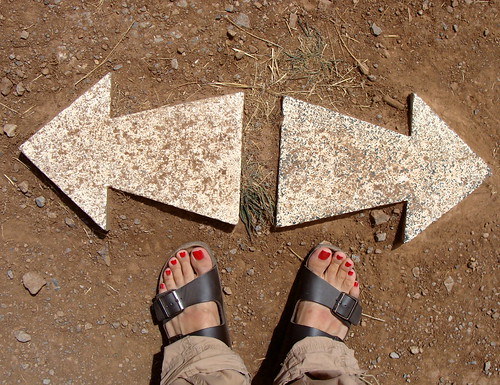 Photo Credit: Julia Manzerova via Compfight
Photo Credit: Julia Manzerova via Compfight
What about big decisions?
Decisions that have some weight to them.
Should I choose this school or that one?
Should I choose this job or that one?
We often have multiple good options to choose from.
Which is the best one?
I’m teaching a class on critical thinking next week and I want to share with you one of the tools I cover.
This tool can help us make better decisions with those bigger dilemmas we face.
You can use this tool for a variety of decisions from choosing vacation spots, to vacuum brands, to choosing the type of work you might enjoy.
The tool is called a Grid Analysis Worksheet.
Here’s how it works:
1. List all your options as row labels on the table. For example, if you are trying to choose between laptop brands you may list Apple, Dell, Toshiba, etc.
2. List all your factors, or criteria, as column headings. Using the laptop example, factors to consider might be cost, speed, hard disk size, etc.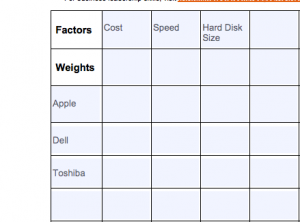
3. Next, give each of your factors a weight on the row labeled “Weights”. Give them a weight from 0 (no importance) to 5 (extremely important) depending on how important each factor is to you. For example, cost may be a 5, speed may be a 3, and hard disk size may be a 0. Note multiple factors can have the same weight.
4. Next, work you way across the table rows, scoring each option on each factor. Score each factor from 0 (poor) to 3 (very good). Note you don’t need to have a different score for each factor. You can score all of your options as 0 if none of them are good for a particular factor. For example, Apple may be a 0 for cost, a 3 for speed, and a 3 for hard disk size.
5. Now multiply each of the scores for your options by the weights you gave each of your factors. For example, if you gave Apple a 3 for speed you will multiple 3 by the weight you gave the factor of speed. In this case you gave speed a weight of 3. So you would multiple 3 by 3 to get a score of 9.
6. Lastly, add up the scores for each of your factors for each option. The option that scores the highest is the option you may want to consider.
If I haven’t completely lost you at this point, I hope you try using the Grid Analysis Worksheet with your next big decision. You’ll be surprised how much more confident you’ll feel about your decision when you’ve run your options through this exercise. Let me know if you try it and how it works out. I’d love to hear from you.
Question: How might you use this tool for a decision you have to make?
(Add your comment below.)
Receive my free ebook 5 Essential Steps to Landing Your Dream Job when you join the Work You Enjoy VIP newsletter list. Sign up here.
2 Responses to “How to Make Better Decisions and Feel Good About Them”

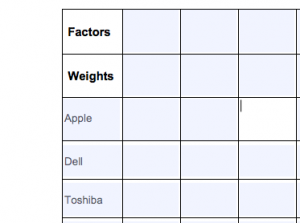
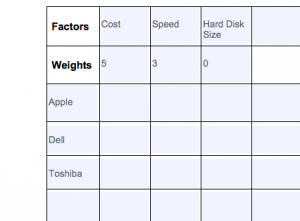
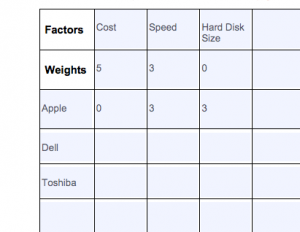
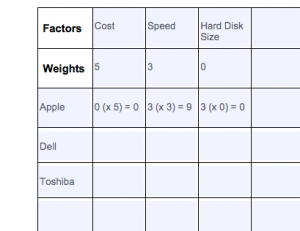
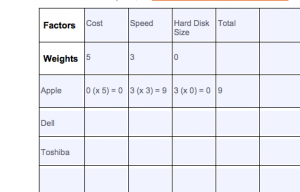
When I’m under the gun, “satisficing” serves me well. Gary Klein wrote a great book on how experts make rapid decisions under fire. (The book is Sources of Power.)
Some of the techniques I use include: criteria and weights, CARVER (Criticality, Accessibility, Return, Vulnerability, Effect, and Recognizability), and Six Thinking Hats. At Microsoft, I tend to use criteria and weight when I need to get agreement with others on what the priorities are. I also tend to use Six Thinking Hats when I need to rapidly have folks change perspective, and take a more holistic view.
At the end of the day, I’ve found that a lot of the decisions come down to who do you want to be and what experiences do you want to create. Basically, the more you can connect your decisions to your “Why” or to your values, the stickier they are.
The secret of changing habits is to first decide who you want to be and our identify helps us pattern match the best fits.
I love that J.D. “satisficing”. Yes, sometimes we just need to do something 80% of the way to make a decision and move on.
I also really like the Six Thinking Hats. We cover that in my class in addition to the grid analysis worksheet. I’m not familiar with CARVER. I’ll have to check that out.
I also completely agree with your assertion that a lot of decisions come down to who we want to be and the experiences we want to create. When we’ve figured those two things out it allows the decision making process to move forward quickly.
Thanks for your comment!